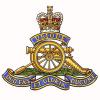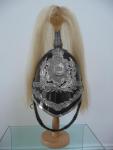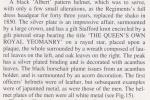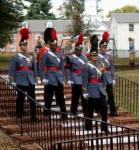-
Posts
44 -
Joined
-
Last visited
Content Type
Profiles
Forums
Blogs
Gallery
Events
Store
Everything posted by theironduke1
-

ww1 tunic
theironduke1 replied to blueman's topic in Great Britain: Militaria: Badges, Uniforms & Equipment
The assumption that what I thought was the Arctic Medal may be something else is probably justified. As suggested, it would have come after the WWI medals and the only expeditions it could have been for was the 1912-14 Mawson, mainly because the others were Scotts ill fated and Shackleton's which he almost certainly wasn't on. (If he were, that jacket would be worth a fortune). The KSA medal could NOT have been worn without the QSA medal either. I almost wish we could get a closer look at the ribbon set. -

ww1 tunic
theironduke1 replied to blueman's topic in Great Britain: Militaria: Badges, Uniforms & Equipment
Hi Kev This is a 1917 pattern service dress tunic for Scottish Regiments wearing Kilts (The version for trews had longer skirts). It differs from the 1908 pattern in that the cuffs have no loops but are plain gauntlet style as the ranking was now on the shoulder straps. You identified him as a Seaforth. Was that from the buttons? The ribbons which I am able to identify are as follows: (Row 1 L-R) Military Cross / Airforce Cross (Original pattern Awarded April 1918) / Arctic Expedition 1912-1914 / King Edward's South Africa Medal 1901-2 (Row 2 L-R) India General Service 1908 / 1914 Star / British War Medal / Victory Medal (Row 3 L-R) Territorial Efficiency Medal 1908 / Unidentified / Unidentified. Seems as if this was quite an adventurous individual, I wish one could find a name, rank or something. He was obviously a Royal Flying Corps officer who had maintained his Scottish regimental identity with his tunic. Especially since had had no collar badges. If he served in South Africa in 1901, he was probably nearing or in his forties by the end of the war, so this may have been his final service. The territorial efficiency medal may mean that he was in the Territorial Force of 1908. I doubt if there were that many RFC officers seconded from the Seaforths with this medal array so it may be worth looking it up. If anyone doesn't agree with my assessment, please post what information you maight have. But this is all for now. Bruce -
Hi John: This is a sweetheart badge from the Boer War era. This was the first conflict in which they appeared and nearly all of them included a horseshoe. By the time of the Great War, sweetheart badges tended to be replicas of the regimental badge, often in coloured enamels. Here are three examples for you. Bruce
-
Identifying uniforms from old photographs can often be tricky. This, after some research through my uniform library, seems to suggest that this could be a group belonging to either the 2nd or 6th Inverness Rifle Volunteer Corps in the 1860s or 70s. Their uniforms were grey with blue collars. At the approximate time of the photo, the 2nd Inverness RVC was HQd in Fort William and the 6th in Kingussie. They became B and F companies of the 1st Administrative Battalion of the Inverness RVC in 1879. Both these units were attached as Volunteer Battalions of the Seaforth Highlanders in 1881 but became the 1st Volunteer Battalion of the Queen's Own Cameron Highlanders in 1883 and later the 4th Battalion of the regiment in 1908 as part of the Territorial Force. At the approximate time of the photo, the 2nd Inverness RVC was HQd in Fort William and the 6th in Kingussie. They became B and F companies of the 1st Administrative Battalion of the Inverness RVC in 1879. I attach an illustration from the excellent work of Sir James Grierson in 1908.
-
Hi Paul: This is certainly an item pertaining to the Royal Irish Fusiliers. Whether it was an official company flag or an unofficial one it may be hard to say. My guess would be unofficial for some inter company competition. The motto (Interestingly spelt the gaelic way) and the Eagle of the 8th French line (Taken at Barrossa in the Peninsular war) are all symbols of the regiment. Impossible to date, but it would be prior to amalgamation with the Inniskillings in 1968. It is now part of the Royal Irish Regiment.
-

royal dragoons helmet
theironduke1 replied to blueman's topic in Great Britain: Militaria: Badges, Uniforms & Equipment
-

royal dragoons helmet
theironduke1 replied to blueman's topic in Great Britain: Militaria: Badges, Uniforms & Equipment
Well, Patrick, it is still a magnificent example of a mid-Victorian headdress. I must say that I have seen sheffield plate when left unpolished for years becomes very 'brassy' looking but usually, a polish will remove the tarnish. It also may have been a regimental experiment to cut costs or distinguish OR's helmets from Officers. Making a brass plate from existing moulds would not have been that difficult. That may be the reason it survived so long by not having been worn much. It just goes to show what a challenge collecting can be whan you cannot clearly see into the past. -

royal dragoons helmet
theironduke1 replied to blueman's topic in Great Britain: Militaria: Badges, Uniforms & Equipment
Patrick. If you have the Ogilby Trust Booklet No. 15 on the Staffordshire Yeomanry, then this post will be superfluous. I am afraid that there is no evidence of the plate or fittings being of anything but white metal. Since the helmet itself was unique (Do I assume you have the black japanned metal one?) it is improbable that the fittings on original manufacture were ever brass. I suppose someone could have fitted a brass plumeholder or rosettes and added a brass curb chain but other than that, I can't help. Hers is a photo and extract from the OT booklet. (Written by R.J. Smith & C.R. Coogan) Bruce http://gmic.co.uk/uploads/monthly_03_2013/post-14012-0-24731100-1362772082.jpghttp://gmic.co.uk/uploads/monthly_03_2013/post-14012-0-32000300-1362772083.jpg -

royal dragoons helmet
theironduke1 replied to blueman's topic in Great Britain: Militaria: Badges, Uniforms & Equipment
Patrick When I started my collection years ago, I decided (like a good collector) to restrict myself to a certain area and I chose the era of Queen Elizabeth II, especially as I joined the Royal Artillery in 1966 and it made sense. I have quite a bit of stuff on the Staffordshire Yeomanry, so I will dig it out and get back to you. Bruce -

royal dragoons helmet
theironduke1 replied to blueman's topic in Great Britain: Militaria: Badges, Uniforms & Equipment
Hi Patrick. Unfortunately, I'm not much of a helmet collector. I do have a couple of them though ... Edwardian RA officers helmet and a German Pickelhaube. I am more of an aficionado and researcher. I have been doing a study on British late Victorian Cavalry uniforms and hope to publish it in a couple of years. I have just finished a book on the Prussian Army which is being published by Casemate in May this year. Also, I have been a badge collector for many years and I have started putting my collection up on my website. It is still a work in process but I have a few boards up now. There you have it in a nutshell. Here is the link to the badge section on my website. http://www.uniformology.com/BG00.html Bruce -

royal dragoons helmet
theironduke1 replied to blueman's topic in Great Britain: Militaria: Badges, Uniforms & Equipment
Hi Patrick. It looks to me like it has been polished ad nauseam over the years .... not by any officer's batman for sure.... possibly some small boy who has worn it to play with. If you think about it, it must be at least 100 years old as the Carabiniers amalgamated with the 3rd DG in 1922 and a different badge was ordered. I have never seen a Carabiniers officer's helmet in photos (close enough to see details) between the late 1860s and 1890s. Although the Dress regulations from 1890 until 1900 record that the officer's badge, like that of the 5th DG was simply to be the number 6 like the other ranks. In his excellent book .. Rowe asserts that no example of the officer's badge using the No. 6 has ever surfaced. Bruce -
Hi Eliott. I find this a very interesting post. My grandfather, Charles Gage was the British Consul in Lourenco Marques at the same time. It is almost certain that he would have known of or even been friends with Norton-Harper. He too had been sent to East Africa by the British Colonial Office to assist in the repatriation of Chinese coolies who had been building the railway there. He had previously beeen in China himself and was in Tientsin during the Boxer Rebellion, serving with the Tientsin Volunteers. He had come to Mozambique in 1904. During the Great War, he was to serve with Lord Delamere's Horse in the East African Campaign and later in the South African Light Horse. He was wounded in a battle near Kilimanjaro in 1916 and repatriated to England. He must have recovered swiftly because we find him in Bilbao, Spain as British Naval Consul in 1917! He had many adventures there (including the capture of a German spy) and for his services to the crown, was awarded a sisal plantation in Tanganyka (Now Tanzania). He died there in 1944. I lived in Kenya, Rhodesia, Mozambique and later South Africa from the mid sixties to the early seventies and tramped over many of the locations that my grandfather had been.
-

royal dragoons helmet
theironduke1 replied to blueman's topic in Great Britain: Militaria: Badges, Uniforms & Equipment
Hi Kevin: I also hope you don't resign. Just wanted to comment opn Patrick's post on the helmet. I agree that in most respects it is a trooper's helmet, however the center of Trooper's badges on the star contained the number '6' on a black leather backing. The circle was a consistent for troopers of all Dragoon Guards & Dragoons .... The Garter with "Honi Soit Qui Mal Y Pense" don't think that ever changed. This badge has an officer's center. -
This is the uniform of an Under Officer at the Valley Forge Military Academy in Wayne, Pennsylvania. I am sure of it for several reasons, the main one being that I lived a 1/4 mile from the academy for 15 years or so and used to love watching their Sunday parades. What I also found interesting as a former British soldier was that all their drill instructors at that time were ex Grenadier or Coldstream Guardsmen who were paid handsomely I understand. Their current Bandmaster is from the Royal Marines ... see photo. http://gmic.co.uk/uploads/monthly_03_2013/post-14012-0-33647000-1362264846.jpghttp://gmic.co.uk/uploads/monthly_03_2013/post-14012-0-88472400-1362264846.jpg
-

royal dragoons helmet
theironduke1 replied to blueman's topic in Great Britain: Militaria: Badges, Uniforms & Equipment
Hi Kevin: I guess i already replied to this one on the Victorian Wars Forum Bruce -

Victorian Rank Badges?
theironduke1 replied to Gregg78's topic in Great Britain: Militaria: Badges, Uniforms & Equipment
Hi Gregg, This is the rank badge of a Troop Sergeant Major of Cavalry for all Dragoon Guards and Dragoons (except 6th Dragoon Guards), all Hussars (Except 11th, 13th & 21st) and all Lancers (Except 17th & 21st). It was worn on the right arm only. The lace pattern (Bias & Stand) was universal (Even for Irish & Scottish regiments in Victorian times) for wear on full dress tunics. Stable jackets, patrol jackets and service frocks tended to use simple gold cloth chevrons with padding behind. After 1902 the bias & stand laced stripes were to be worn on all uniforms except khaki. Strangely enough, the full dress gold lace chevrons were often to be seen on the khaki service jackets worn in the Sudan and Boer wars. Hope this helps Bruce PS. The Crown over 3 Chevrons (With a red backing) was also worn by Battery and Staff Sergeants in the Royal Artillery. However, there was a gun badge between the crown and chevrons, liikewise for the Army Ordnance Corps who had a crossed hammer & pincers badge between. -

belt plates etc
theironduke1 replied to blueman's topic in Great Britain: Militaria: Badges, Uniforms & Equipment
The Center VR Waistplate was worn on the full dress girdle of all the Dragoon Guards regiments except the 4th (Royal Irish) Dragoons and the 1st (Royal) Dragoons. The 4th DG, the Royal Scots Greys and Inniskilling Dragoons had special patterns.










